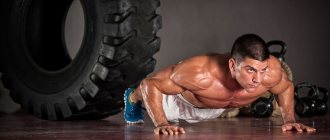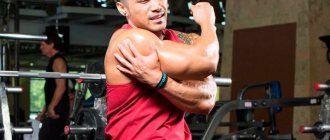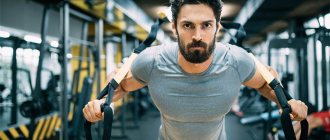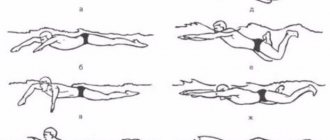Injury prevention and recovery tools [ edit | edit code]
Any injury that forces you to temporarily stop training or limit your loads causes harm not only physically, but also psychologically, as it forces you to mark time or throws you back.
Therefore, you need to be careful about prevention and recovery. First, you need to understand the causes of the injury, as well as how to distinguish a possible injury from muscle post-workout pain. The cause of muscle pain is the workout itself. The pain is especially severe during the first training sessions. It is quite possible that over time it does not become weaker, your attitude towards it simply changes.
If at first it only causes inconvenience, then for an experienced athlete it gives satisfaction from the work done in the gym. Massage, light warm-up, warm baths, and a sauna will help you cope with muscle pain.
https://youtu.be/hGY142sLRSw
How to avoid injury and damage when doing exercises
If you want to build muscle, and you don’t need joint injuries in bodybuilding at all, you need to follow only three basic rules during exercise:
- Proceed with basic exercises only after thoroughly warming up the muscles. To do this, before each lesson, perform an aerobic warm-up - stretching, riding an exercise bike, and so on. A few minutes of preparation before lifting weights can save you from serious and painful injuries.
- Carefully practice the correct sequence of performing the exercise. Technology is important in all processes, including sports activities.
- When working with heavy weights, protect yourself by the constant presence of another person nearby. An assistant will be able to remove excess weight or grab a heavy barbell if he sees that you can’t cope or are already tired.
Special kinesio tapes - special types of stickers on the skin that have a number of useful properties - will also help you cope with heavy loads and heavy loads. They are able to prevent muscle strain, joint damage, reduce pain and quickly return the victim to duty. In addition, unlike outdated elastic bandages and bandages, kinesio tapes have an aesthetic appearance and stay firmly on the body for up to several days of continuous wear.
When doing bodybuilding, remember that you are not fighting for existence, but just want to get healthier and make your body stronger and more attractive. There is no need to strain yourself and work hard. Give yourself the opportunity to rest, especially since muscles grow during rest. If you have constant overload, the only thing you can easily and quickly earn is muscle and ligament ruptures, tissue and joint damage.
Causes of injuries in the gym [edit | edit code]
There are several reasons why injuries occur.
- Violation of the exercise technique. This is the most common reason.
If the movement technique is violated, the exercise becomes uncomfortable and the result in the form of an injury will not take long to come. Do not hesitate to seek advice from a trainer, control your movements using a mirror.
- Failure to comply with the rules of conduct in a sports club and especially during training. This includes uncleaned equipment that can cause you to trip, barbell discs that are not secured with locks, and idle talk that distracts you from your workout.
- Neglecting equipment when working with heavy weights. Use resistance bands, wrist bands, and a belt when performing squats, deadlifts, clean and jerks, and heavy presses.
- Inappropriate shoes. Shoes that do not support the foot can lead to both muscle strain and joint injuries.
- Neglecting a proper warm-up. Poorly warmed muscles not only get injured faster, but also take longer to recover.
- Poor training plan or lack thereof. In other words, sudden changes in working weight towards increase. Muscles are forced to work in a mode for which they are not ready, which can cause sprains and tears.
It could also be training too often. Muscles, tendons and your psyche may not have time to recover in short periods of time, which will lead to local injuries, general overtraining and weakened immunity. It is important to remember: the world does not end outside the walls of a sports club. There are many ways to spend your leisure time. Read, watch movies, chat with friends. Try to diversify not only your training, but also your rest.
- Working without insurance. Never perform an exercise alone unless you are confident, lifting close to max weight, or learning a new movement.
- Lack of medical supervision. You may not even be aware of some disturbances in the functioning of the body, which, under the influence of training, can result in more serious problems. Visit your doctor before starting training. By the way, it wouldn’t hurt to visit it at regular intervals.
Causes of injury
The easiest way to injury is not following the proper technique for performing exercises while simultaneously lifting heavy weights. Also, you can easily get injured if you don’t follow the rules of conduct in the gym. Always remove discs, dumbbells, barbells, handles and other equipment after you, as they can cause people to trip, fall and, consequently, get injured. Neglecting to use safety equipment, such as an athletic belt, wrist, knee and elbow bandages, can also lead to injury. Always use these tools when performing heavy exercises, or when working with heavy weights in any exercise, in order to protect yourself from injury. Unsuitable shoes can also cause injury during exercise. If your shoes do not support your feet, it can lead to muscle strains or joint injuries. Working without insurance, that is, without a partner, can also lead to injury if the weight of the projectile is large enough. When working in strength mode until your muscles fail, having a spotter is extremely necessary for you, otherwise it will not be difficult to get injured.
ADVICE. We directly talked about the importance of following the rules of behavior in the gym in the article “Preparing for your first visit to the fitness club.” In it, we described what you need to know before starting classes at a sports institution. We paid special attention to the importance of wearing equipment, and also described in some detail the etiquette of behavior, which we strongly recommend that literally everyone familiarize themselves with, regardless of your training experience.
ADVICE. You can read about sports equipment, its purpose and functions in our article “Purpose of sports equipment”. From it you will learn what an arm blaster is, the difference between athletic and gymnastics straps, the difference between gloves, palms and wrist hooks, and the difference between sneakers and weightlifting bars. In total you will find 18 pieces of sports equipment with their descriptions and purposes.
Prevention, diagnosis and treatment of injuries [ edit | edit code]
Clearly setting goals and objectives, proper nutrition and adequate recovery will help you protect yourself from injury. But if you do get injured, you need to know how to fix it. For example, you can eliminate minor bruises and sprains yourself.
Below are the symptoms and presentations of some common injuries.
Bruises [edit | edit code]
Injury
- closed damage to tissues and organs. In most cases, the person who is bruised understands and remembers what happened to him. But it happens that during training you accidentally caught on something, but were so carried away that you didn’t pay attention to it. The next day, you wonder where this dull pain and huge bruise or abrasion come from. The bruise can actually be huge because during training the capillaries were filled with blood and burst from the impact.
Symptoms
: pain (occurs at the time of injury, later felt when touched), swelling or swelling (develops over several hours), hematoma (bruise, hemorrhage).
Treatment
: For most bruises, medical attention is not necessary.
To stop internal bleeding, cold compresses are used (1-2 days for 5-10 minutes several times a day), rest, and a fixing bandage. After the swelling subsides, use ointments to resolve the hematoma, self-massage. Recovery time is 1-3 days.
Dislocations [edit | edit code]
Dislocation
- displacement of joint surfaces. If the surfaces partially touch, then this is a subluxation. If they do not touch, which is much worse, then it is a complete dislocation.
Symptoms
: the damaged joint has an unusual shape, the limb is unnaturally twisted, movement and touch cause acute pain.
Treatment
: See your doctor first as x-rays may be needed to confirm the diagnosis. As a rule, after an x-ray, the doctor realigns the joint and applies a fixing bandage.
It is very important to see a doctor as soon as possible. Then the reduction will be less painful and will most likely take place without surgical intervention. Recovery time depends on the severity of the dislocation. This may take about 3 weeks, during which you may need to undergo physical therapy and other procedures. It is very important not to overly dramatize the situation, but to carry out all recovery procedures.
Sprains and torn ligaments [edit | edit code]
Stretching and tearing
- injuries that occur due to the load on the ligamentous apparatus of the joint and muscles exceeding the elasticity of the tissues. Sprains and ruptures occur during sudden movements in the joint that exceed its normal amplitude and do not coincide with the usual direction of movement. Much more often, muscle strain is a consequence of poor warm-up.
Symptoms:
limited movement in the damaged area, swelling, pain with movement and touch.
During muscle rupture (at the time of injury), a specific crunching sound is possible.
Treatment:
In the first few hours after a sprain, ice should be applied to the injury site. 2-3 cold compresses for 10-15 minutes will be enough. Then you need to secure this place with an elastic bandage.
Most sprains can be treated on your own.
To do this, for the first few days you need to continue to make a cold compress, applying it for 5-10 minutes several times a day.
It is also necessary to use anti-inflammatory and analgesic ointments. Loads should be reduced or stopped. For an accurate diagnosis, it is better to consult a doctor. Complete separation of the muscle from the tendon and the tendon from the muscle is extremely rare. Recovery time is about 2 weeks.
Muscle groups and types of injuries.
The most common injuries are ligaments and tendons . This is due to the fact that ligaments and tendons have little elastic structures, and they are subject to very large loads when working with weights. Therefore, when drawing up a training program, you must not forget about them; there are special techniques for this.
You can also encounter injuries to bones and joints , which are much less common than previous injuries, especially fractures. This is due to the specifics of the athlete’s training process. For example, in hockey, these injuries are much more common due to impacts and collisions.
Stretches.
Sprain
Sprain
- a common type of injury. A sprain usually occurs when there is sudden movement of a joint beyond its normal range. Most often, the ligaments of the ankle and knee joints are sprained.
A sprain of a ligament is in fact always a rupture, either at the microscopic level - with a small sprain, or at the level of individual collagen fibers - with a moderate injury, or - with a severe injury - a rupture of the entire ligament. However, ligaments have a high regenerative ability, in most cases allowing them to heal on their own even after a complete rupture.
Dislocations and subluxations.
A joint dislocation is a displacement of the articular ends of bones with their complete divergence, which causes dysfunction of the joints.
Subluxation is not a complete dislocation of the joint, in which the articulated surfaces of the bones are displaced, but the contact between them remains.
Traumatic dislocations are often accompanied by rupture of the joint capsules; tendons, muscles, bones, blood vessels and nerves can also be damaged.
Most dislocations are a fairly serious injury that leads to further functional impairment, and sometimes can be life-threatening, as for example when the cervical vertebrae come out.
Bruises.
Injury
– this is closed damage to tissues and organs without significant disruption of them
structures. The most commonly damaged superficial tissues are the skin, subcutaneous tissue, muscles and periosteum. Soft tissues, which are pressed against the bones at the time of injury, are especially affected by a strong impact.
As a rule, when a bruise occurs, victims experience more or less intense pain. Hemorrhage at the site of a bruise usually manifests itself as a bruise - a blue-purple spot, the color of which gradually changes to greenish and yellow.
It usually occurs as a result of a blow from a blunt object or a fall.
Muscle separation.
Separation is usually preceded by a high load on the tense muscle, causing
her to perform excessive yielding work. The separation is accompanied by acute pain, and in children and adolescents, sometimes also a clicking sound. The specific mechanism of damage depends on the location of the avulsion. Thus, separations in the area of the ischial tuberosity occur due to extension of the leg at the knee joint and flexion at the hip; This is a classic injury among water skiers and steeplechase athletes. Inferior anterior iliac spine avulsions occur when the hip is extended or the shin flexed against the resistance of the quadriceps femoris muscle, as occurs during sprinting and kicking. Avulsions in the area of the superior anterior iliac spine occur from forced extension of the thigh and lower leg. Recovery from avulsions and avulsion fractures in the area of the superior or inferior anterior iliac spine requires an average of 4-6 weeks. In the absence of complications, return to sports can take several weeks to several months.
Fracture.
Bone fracture
- complete or partial violation of the integrity of the bone under a load exceeding the strength of the injured skeletal area. Fractures can occur either as a result of trauma or as a result of various diseases accompanied by changes in the strength characteristics of bone tissue.
The severity of the condition during fractures is determined by the size of the damaged bones and their number. Multiple fractures of large tubular bones lead to the development of massive blood loss and traumatic shock. Also, patients recover slowly from such injuries; recovery may take several months.
Upper shoulder injuries:
Most common injuries:
- tear of the rotator cuff (rotator cuff tendon);
- stretching of the heads of the deltoid muscles/tendons at the junction of the muscle and the bone;
- inflammation of the deltas (bursitis of the tendon bursa);
- rupture/tear of the supraspinatus muscle.
Separately, you can endure the following injuries to the elbow joint:
- tendonitis (inflammation of the tendon) of the biceps;
- separation of the long head of the biceps;
- inflammation of the triceps (ulnar bursitis);
- triceps tendon rupture;
- elbow sprain;
- arthritis of the elbow joints.
Lower limb injuries
Leg muscles:
- calf muscle strain;
- Achilles tendon sprain/rupture;
- displacement of the kneecap;
- sprained knee/hamstring ligaments;
- knee meniscus tear;
- biceps femoris strain;
- quadriceps stretch.
As for the back muscles, the injuries are as follows:
- intervertebral disc herniation (displacement);
- pinched nerves of the spinal column;
- pinched sciatic nerve;
- “breakdown” of the back (stretching of the extensor muscles);
- stretching of the muscles of the upper back (including the neck).
Injuries in bodybuilding
Any athlete, making even the most seemingly harmless movements, armed with minimal weights, runs the risk of injury. At best, tendons and ligaments suffer, but one cannot discount the bones, which are also at risk. Bodybuilding is different in that here joints and bones are injured much less frequently, since you have to deal with weights, where there are practically no different accelerations, such as in football or hockey, as well as other dynamic sports games, where joints and bones suffer more. In bodybuilding and powerlifting, injuries mainly occur in the form of sprains or dislocations. For example:
- Sprains are associated with damage to the ligaments and tendons, which leads to their deformation, stretching and even rupture.
- Dislocations lead to disruption of the normal functioning of the joints, which leads to a loss of normal functioning of the surfaces relative to each other.
Causes of sports injuries
According to doctors and fitness instructors, the most common injuries in bodybuilding are sprains and torn ligaments, and broken limbs. The causes of injuries can be very diverse, but usually arise under the influence of the following factors:
- athlete training with “not his own” prohibitive weights;
- violation of the technique of performing a particular exercise;
- unbalanced training of different muscle groups;
- pathologies of the body structure of a physiological nature (difference in leg length, pelvic distortion);
- chronic diseases (lordosis, osteochondrosis);
- problems with coordination;
- unbalanced diet;
- insufficient warming up of muscles during warm-up;
- carelessness, carelessness or simple carelessness.
Causes of injuries in bodybuilding
The main root causes of injury in bodybuilding are: the use of large training weights, the use of high-amplitude movements, the lack of warming up of muscles and ligaments before training, and the practice of sudden stops of movements.
As a rule, inexperienced athletes practice quickly adding mass to equipment, which sooner or later will make itself felt by spraining the ligaments and tendons. In this regard, it should be recalled that adding weights should be gradual, which will guarantee the safety of the exercises.
Some athletes neglect warming up, believing that it takes away useful time, as well as strength. This approach to the training process does not lead to anything positive. When muscles are not warmed up properly, even when working with conventional weights, ligaments may become deformed or stretched, which is associated with a loss of muscle elasticity. Particular attention should be paid to warming up the muscles during the cold season.
Almost all exercises for an athlete’s ligaments are considered dangerous. In this case, you should pay attention to the exercises that most often lead to injuries in bodybuilding. For example:
- Squats with heavy weights . Such exercises, if not preceded by a good long warm-up, always lead to injuries to the knee joints. This is due to the fact that the main load in such conditions falls on the knees. If you squat to parallel, the load is partially removed. When performing such exercises, you should not allow your knees to move inward.
- Deadlifts cause great harm to the lumbar ligaments if the correct technique is neglected, which is always practiced with minimal weights. Such injuries lead to limitation of any inclined movements and even movement. When lifting the barbell while standing, you should always keep it as close to your body as possible.
- Chest and delt presses lead to dysfunction in the shoulder girdle. If you overestimate the load on muscles and ligaments, this will immediately lead to their deformation and stretching. When the barbell is pressed while standing and the lower back bends, injury to the spine is possible. Such an exercise is excluded from the list of athletes' competitions. Therefore, the barbell press should be carried out with a straight spine and with lighter weights - after all, health is always more valuable than any achievements. The overhead barbell press is also considered a traumatic exercise, as unnatural joint movements occur. Since the shoulder girdle does not have adequate flexibility, it is quite easy to get injured, especially when working with heavy loads. When performing such an exercise, it is better not to lower the barbell below the level of the back of the head.
- French press . This exercise is dangerous because it can cause irreparable injuries to the elbow joints if you neglect the training rules and use excessive weights. The main exercises for triceps are dips or close-grip presses.
Feeling pain
Pain can be beneficial if addressed early because it reminds the athlete that injury is a possibility. Painful sensations indicate that it is better to reduce the load on the corresponding parts of the body, otherwise additional actions can lead to unpredictable consequences. In such cases, it is better to stop and stop further movements until the pain subsides. Naturally, this leads to the loss of precious time, but there is no other way. This is retribution for rash actions.
Minor injuries are a constant occurrence. And that's okay
The average person rarely gets injured. Once or twice a year, or even less. I twisted my leg, sprained my ankle, hurt myself, cut myself while chopping potatoes into borscht, etc., etc.
If a person constantly works with weights, and even more so plays sports professionally, then various kinds of muscle tears, sprains, minor inflammations of joints and ligaments haunt him constantly. And that's okay. Constant stress wears out the connective tissue and it does not always have time to recover in time. The main thing is not to panic, to react quickly and not to cause serious injuries. And you also need...
...Keep your diet
This is especially true for the amount of protein consumed (1.5-2/2-2.5+ g per kg of body weight for women/men when playing sports). After all, connective tissue (ligaments, tendons) that is constantly under load is the same protein. To restore it, we need amino acids, which we get from protein foods. If there is no protein, there will be no recovery, or it will not be very effective.
The fact is that the body first of all releases free amino acids to restore vital internal organs. And if these same amino acids are not supplied enough from food, then they are taken from your own muscles and even from connective tissue.
Simply put, joints and ligaments are not critical for the functioning of the body and are restored according to a residual principle. It is for this reason that people may have pain in their knees, elbows, and shoulder joints that were accidentally injured or brought to the point of noticeable wear and tear for years - there are not enough resources for recovery. Besides…
…Movement is life!
Often a person severely limits the movement of the part of the body that is bothering him, believing that complete rest will solve the problem. This is wrong.
For example, to maintain the elasticity of the intervertebral discs and their nutrition, movement in this area is necessary. During this process, the disc absorbs nutrients like a sponge and releases decay products. If there is no movement, then there is no circulation of substances, degradation of the intervertebral discs occurs, and later - pinched nerves, protrusions and other troubles.
The situation is similar with the joints, only there the synovial fluid is responsible for the circulation of nutrients. No movement in the joint means no circulation, which means no recovery.
My words are supported by protocols for treating problem joints when there is no serious inflammation or ligament rupture. In particular, first of all, the joint must be anesthetized, which will allow a person to actively move it and at the same time nourish it with useful substances.
High-quality glucosamine-chondroitin complexes are built on the same principle, which, in addition to glucosamine and chondroitin, also include methylsulfonylmethane (MSM). The latter has pronounced anti-inflammatory properties specifically in relation to joints. It significantly reduces pain, allowing you to move your limbs more actively. More movement means faster and more nutrients will be delivered to the joint to restore it.
But all this was a theory that could still be talked about for a long time. For us, practice and specific advice are more important. I’ll tell you about the problems that I encountered myself and which I successfully solved.
Treatment of sprains and dislocations
Treatment with restriction of movements . When any limb is injured in bodybuilding, it is better to leave it alone for several days. The term depends on the severity of the injury. If you tightly fix, for example, a joint, this will somewhat speed up the rehabilitation process.
Cold treatment . A similar treatment option has also been known for a long time. If you don’t want to see a swollen limb, then it is better to apply ice to the site of the bruise every 40 minutes, especially in the first day after the injury. In the future, ice can be applied less often.
The most common injuries in bodybuilding
For athletes who are seriously involved in sports, injury can be a big problem. Experienced athletes are well aware that any deficiency in physique can be eliminated with the help of training and an appropriate nutrition program.
If you have problems with excess weight, reduce your caloric intake and reduce the amount of fat and carbohydrates you consume. If a certain part of the body is lagging behind in its development, then add certain exercises to your training program. But with injuries everything is very difficult.
Surely many athletes have noticed that injuries most often occur at the moment when they are at the peak of their athletic form. This is not an accident and most often athletes are injured precisely after a period of stable progress. But there are ways to avoid these troubles. Today we will talk about the most common injuries in bodybuilding.
The risk of injury increases the moment you train consistently and have already made significant progress. The main reason for this is a drop in vigilance. The athlete knows that his form is excellent and can stop paying the required attention to warming up. He is quite satisfied with his personal successes, and there is a desire to increase working weights or, say, start to often use elements of cheating in training.
At this moment, any injury is even more offensive than if you are in poor sports shape. Often people, and not only athletes, do not pay attention to the first danger signals and only worsen the situation. The athlete continues to train intensively, which ultimately leads to injury.
It is possible to avoid injury, but it is not easy to do. Athletes must learn from their mistakes. Today we will find out how you can prevent injuries and look at the most common ones.
Kinesio taping for injuries
Scientists and great medical luminaries smile at this practice. Studies have been conducted, according to which no serious effect was noticed from kinesio taping. But the funny thing is that they tried to heal the injury using this method, but in fact it is only an auxiliary tool. Another physical therapy option that works in synergy with other restorative initiatives.
Pay attention to the Olympians - runners, volleyball players, football players - you can often see multi-colored ribbons on them. These are kinesio tapes that activate lymph flow in the damaged area, partially relieve swelling and generally promote faster recovery.
By the way, it was at the 1988 Olympic Games in Seoul that kinesio tapes appeared on the Japanese volleyball team. After this, the practice was picked up by other physiotherapists, traumatologists and massage therapists. It was developed even earlier - in 1973 by Japanese chiropractor Kenzo Kase . Then he began to apply this procedure in his practice, and in 1979 he described its basic principles and put it into practice, so to speak.
In my case, kinesio tape allowed me to speed up recovery by two weeks. Perhaps the effect would have been even better if I had pasted it earlier. But he came to the specialist only a month after the injury. The video below explains all this in detail:
https://youtu.be/WZqCq1Edaxo
And here is the final review on the results of therapy:
Injury Prevention
The main and most effective preventive action is warming up. If you ignore it, there may be a lot of injuries, and you will not be able to achieve your goal. Of course, stretching is also important, but warming up is still a more effective remedy.
For example, before training the upper body, you can perform 3 warm-up movements and then stretch the muscles well. The first of these exercises may be the “mill”. Make rotational movements with your arms in front of you while bending over. The arms should be straight, and rotational movements should be made by the shoulder joints. This will prepare the ligaments and joints for serious work.
The second warm-up exercise is similar to the first, but the arm movements are performed backwards. After this, you should pay attention to stretching the chest muscles. There are quite a lot of warm-up exercises for all muscle groups, and they must be part of your training program.
Injury tendonitis of biceps and shoulders
This injury is often mistaken by athletes for damage to the shoulder joint, since pain occurs in this area. However, biceps tendonitis is the tendon coming out of its bed, which is located on the upper part of the chamerus. This is the largest bone of the humerus. Almost always this damage can be corrected. Pain sensations appear in the area of the anterior delta bundle, which allows it to be mistakenly diagnosed as bursitis.
The biceps tendon must be returned to its rightful place, as otherwise inflammation of the shoulder joint may develop. The cause of this injury is most often exercises for the pectoral muscles, in particular bench presses and Peck-Deck flyes.
If you have received this injury, you should avoid any strain on the pectoral muscles. Start taking anti-inflammatory medications, such as Ibuprofen, and apply cold to the shoulder. When the swelling goes away, it is necessary to put the tendon back. However, this is quite difficult to do and it is advisable to contact a specialist.
Once the injury has been resolved, you can return to training with some caution. First of all, you should exclude a wide grip in all exercises.
Diagnosis and symptoms of an injured elbow joint[edit | edit code]
The elbow joint has a complex anatomical structure, which makes it both strong and vulnerable. It is a complex connection of the shoulder bone with the radius and ulna bones of the forearm. There are no blood vessels in the cartilage, so the nutrition of the joint tissue is slow and occurs only through synovial fluid. It is not surprising that long-term training accompanied by lifting heavy weights has a destructive effect on the elbow joints. The consequences of prolonged uncontrolled exposure through strength exercises are in most cases disastrous and without proper treatment can lead to severe arthritis.
Problems with the elbow joints, as a rule, do not arise overnight, but accumulate over years. The first signs that strength athletes should pay special attention to are mild pain and a slight decrease in the working amplitude of the joint during training.
Occupational elbow diseases among many “siloviki” are epicondylitis and tendinitis. Epicondylitis is accompanied by severe progressive pain, which increases when you try to clench your hand into a fist or hold any object in it.
The cause of acute pain in epicondylitis is inflammation of the ligamentous mechanism of the elbow, which is caused by a decrease in metabolic processes. With this disease, the joint is not subject to swelling or redness and retains its normal appearance. Epicondylitis most often occurs in athletes who have crossed the thirty-five year age mark.
Elbow tendonitis is accompanied by inflammation of the tendon tissue. The cause of this disease is training overload. Pain occurs during active movements that involve the injured tendon. Probing the tendon also causes painful discomfort. With passive exposure there is no pain. The temperature of the skin in the area of the damaged tendon is increased, and the slightest movement of the joint is accompanied by a characteristic crunch.
Damage to the capsular-ligamentous apparatus.
Diagnosis of this injury in the acute period is difficult. The possibility of rupture of the capsule and ligaments is indicated by an indirect mechanism of injury and a significant degree of physical effort. Symptoms of injury are comparable to those of a bruise, but the localization of swelling, subcutaneous hemorrhages and pain along the lateral surfaces of the joint deserve attention. Convincing diagnosis of damage to the collateral ligaments, especially partial ruptures, is possible only with full extension in the joint. Complications of damage to the capsular-ligamentous apparatus are often impaired mobility and less commonly instability of the joint.
Elbow injuries
The elbow joints are also the most traumatic area on an athlete's body. They can be divided into two groups:
- The first
should include all injuries to the upper arm (the attachment point of the long head of the triceps). They are also called “bone spurs”. These injuries are very common among bodybuilders. This type of injury can be caused by the French press. The best option for preventing injuries in this category is to replace the French press with alternative exercises.
- The second category of
elbow injuries includes injuries to the forearms. They are also called tennis elbow. It is also widespread among bodybuilders. For example, pulling a barbell in the direction of the chin can lead to such damage.
As soon as you experience the first symptoms of this injury, you should immediately stop exercising and, after resting, use exercises to strengthen the shoulder joint. Bodybuilders should maintain a balance in the development of all muscles, not only because it looks aesthetically pleasing, but also to reduce the risk of injury.
For more information about the most common injuries in bodybuilding and methods of prevention, see here:
Rehabilitation of elbow joints and ligaments
One of my latest practices involves elbows. From time to time there was pain in the left elbow, then in the right, sometimes I slightly injured the ligaments of the forearms at the elbow and made do with an elastic bandage and simple pumping (you find a position in which pain is felt in the elbow ligaments, and you begin to carefully load them with a block or light dumbbells a large number of repetitions until you feel a pump - the same as with a muscle tear).
But this time, during the drying process, I still overdid it and managed to pull and inflame the ligaments both on the outer and inner sides of the forearm at the right elbow, and on the inner side of the left. This was not a strain, but rather overworked my arms: pull-ups with 30-40 kg on a belt and without straps, deadlifts up to 150 kg without straps, etc. Although a year and a half ago I used straps, even when 80-80 kg was hanging on the barbell. 100 kg or when pulling up without additional weight on the belt. But grip training is a completely different story. The bottom line is that the articular-ligamentous apparatus adapts to the load a little slower than the muscular corset, which is what causes this type of injury.
It’s just that the elastic bandage on my arms didn’t really help, I didn’t have time to pump it up in the sense that it helps for one and a half to two months, and I had active rest planned before moving on to the next training program in just two weeks. Active is when the weight of the weights is reduced to 50-60% of the working weight and without increasing the number of repetitions or approaches.
I decided to take the advice of a professional tennis player (elbows are their eternal problem), who gave the following recipe for a compress on the elbows :
- 1 ampoule of dexamethasone;
- 1 ampoule of analgin;
- 1 ampoule of lidocaine;
- 1 cap of dimexide.
All this is mixed and a compress is made on the elbow and elbow ligaments at night. I soaked several layers of gauze, applied cling film to the damaged area and wrapped the entire structure with an elastic bandage without much tension. The above is one serving per cubit. Recommended treatment is 10 days.
The effect is amazing. The left elbow was completely restored, the right one is still felt, but it only needs to be developed a little. I already do the French press with working weights (up to 5o kg) without any problems.
I also recommend the use of warming ointments. In particular, I work with finalgon (be careful - it’s very sticky, spread with the included applicator, a thin layer and an amount of no more than a pea) - it helps well with elbows and knees. A less harsh alternative is apisatron . I use it immediately before training to quickly warm up joints and ligaments.
Injuries in bodybuilding
Content
Many visitors to gyms and fitness clubs at some point are faced with the problem of injuries of various kinds. This topic still remains extremely relevant and important, because no one is immune from this, and there is almost no quality information on the topic on the Internet, or it is extremely generalized and does not address precautionary measures, prevention and elimination of the problem. This article was written from my practical experience for more than 4 years in competitive bodybuilding and is exclusive to the iq portal - body.ru, it is intended both for experienced athletes and for people just starting their journey in such a wonderful sport as bodybuilding. Let's figure out what's what and where leg injuries in the gym come from.










